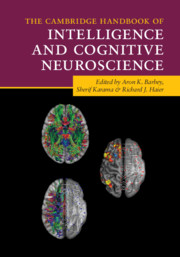Book contents
- The Cambridge Handbook of Intelligence and Cognitive Neuroscience
- Reviews
- The Cambridge Handbook of Intelligence and Cognitive Neuroscience
- Copyright page
- Dedication
- Contents
- Figures
- Tables
- Contributors
- Preface
- Part I Fundamental Issues
- Part II Theories, Models, and Hypotheses
- 5 Evaluating the Weight of the Evidence
- 6 Human Intelligence and Network Neuroscience
- 7 It’s about Time
- 8 A Lifespan Perspective on the Cognitive Neuroscience of Intelligence
- 9 Predictive Intelligence for Learning and Optimization
- Part III Neuroimaging Methods and Findings
- Part IV Predictive Modeling Approaches
- Part V Translating Research on the Neuroscience of Intelligence into Action
- Index
- References
9 - Predictive Intelligence for Learning and Optimization
Multidisciplinary Perspectives from Social, Cognitive, and Affective Neuroscience
from Part II - Theories, Models, and Hypotheses
Published online by Cambridge University Press: 11 June 2021
- The Cambridge Handbook of Intelligence and Cognitive Neuroscience
- Reviews
- The Cambridge Handbook of Intelligence and Cognitive Neuroscience
- Copyright page
- Dedication
- Contents
- Figures
- Tables
- Contributors
- Preface
- Part I Fundamental Issues
- Part II Theories, Models, and Hypotheses
- 5 Evaluating the Weight of the Evidence
- 6 Human Intelligence and Network Neuroscience
- 7 It’s about Time
- 8 A Lifespan Perspective on the Cognitive Neuroscience of Intelligence
- 9 Predictive Intelligence for Learning and Optimization
- Part III Neuroimaging Methods and Findings
- Part IV Predictive Modeling Approaches
- Part V Translating Research on the Neuroscience of Intelligence into Action
- Index
- References
Summary
Many different definitions of intelligence exist but, in the end, they all converge on the brain. In this chapter, we explore the implications of the simple idea that, ultimately, intelligence must help optimize the survival of the individual and of the species. Central to this evolutionary argument, intelligence must offer superior abilities to learn and flexibly adapt to new challenges in the environment. To enhance the possibility of survival, the brain must thus learn to make accurate predictions that optimize the amount of time and energy spent on choosing appropriate actions in a given situation. Such predictive models have a number of parameters, like speed, complexity, and flexibility, that ensure the correct balance and usefulness to solve a given problem (Deary, Penke, & Johnson, 2010; Friedman et al., 2008; Fuster, 2005; Houde, 2010; Johnson-Laird, 2001; Kringelbach & Rolls, 2004; Roth & Dicke, 2005). These parameters come from a variety of cognitive, affective, and social factors, but a main requirement is one of motivation to initiate and sustain the learning process. Finally, one thing is to survive, another is to flourish, and so we discuss whether the intelligent brain is also optimal in terms of wellbeing given that spending too much time predicting something that may never come to pass could be counterproductive to flourishing. Thus, in this perspective, intelligence can be thought of as the process of balancing and optimizing the parameters that allow animals to survive as individuals and as a species, while still maintaining the motivation to do so. Improving the predictive, intelligent brain is a lifelong process where there are important shifts throughout the lifespan in how different aspects and parameters are prioritized.
- Type
- Chapter
- Information
- Publisher: Cambridge University PressPrint publication year: 2021



